Early in the morning of Friday 18th February, about ten miles north of Corfu and 25 miles west of Albania, a fire broke out on the vehicle deck of Grimaldi Lines? Euroferry Olympia (ex-Transeuropa). As of now, three people remain missing with eight confirmed dead, all apparently drivers who had been sleeping in their vehicles during the crossing. On Wednesday 23rd February the ship was towed to the large, underutilised port of Platygiali in Greece where shore-based firefighting efforts could continue.
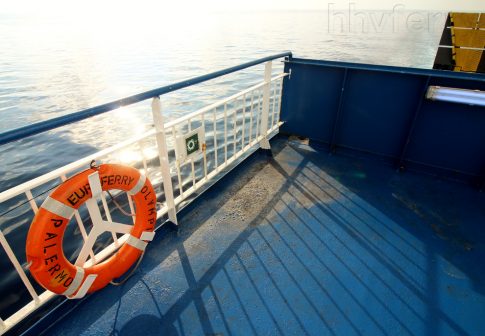
This tragedy was almost a carbon copy of the similarly disastrous loss of the Norman Atlantic and 22 lives in 2014: a ship heading from Greece to Italy, featuring open vehicle decks and a crew unable to come close to dealing with the disaster enveloping them; truck drivers sleeping in their cabs on the vehicle deck, an operator who deflected questions. Has nothing really been learned from that disaster? Are ships with open vehicle decks doomed whenever a fire breaks out on them? Is it even safe to operate such vessels with passengers on board?


Euroferry Olympia (ex-Transeuropa) – a brief history
At either end of the central alleyway linking the main reception and the restaurant on the Euroferry Olympia stood a pair of bronze figures by the French sculptor Serge Mangin. They were called ‘SOS – Save our Seas’ and were copies of the original statue which stands in Westerland on the island of Sylt in Germany. Their presence represented the high expectations and high standards the ship?s original owners, Poseidon Schiffahrt, had for its ships and its operations.



Poseidon Schiffahrt was for many years a partner to Finnlines in their long-distance Finncarriers operations and in 1994/95 the partners took delivery of a quartet of large ro-pax ferries with limited, but very high quality passenger accommodation for around 100. Three of the vessels, the Finnhansa, Finnpartner and Finntrader would be owned by Finnlines whilst the other, the third-built, would be named Transeuropa and would wear Poseidon?s red hull colours. The ships were destined for the 36-hour long operation between Helsinki in Finland and L?beck in Germany which operated in parallel with the famed gas turbine-powered cruise ferry Finnjet, once of Finnlines but by then in Silja Line colours. Consequently, although they were marketed to discerning tourists, the majority of their traffic was likely to be freight and truck drivers.

The series were the culmination of a design evolution which stretched through a series of generations back to the original Finncarrier of 1969 and were fitted out to a very high standard, with berths provided for all on board in very large, comfortable cabins, almost all of which were outside with large windows looking out to sea or over the open freight decks fore and aft. The rectangular accommodation block also contained a sauna, whirlpool and small swimming pool complex as well as a main bar and buffet restaurant. A lido bar was provided adjacent to the sauna area whilst a covered verandah overlooked the tiered outside decks where, on the Transeuropa, an area was set aside for mini golf.


The ships had four freight decks: from top to bottom these comprised a lower hold, the main vehicle deck, Deck 3 (partially open at the stern) and Deck 4 (forward of the superstructure, entirely open to the elements). Decks 3 and 4 were accessed via fixed ramps, the former direct from the stern on the starboard side whilst the ramp up from 3 to 4 was to port.



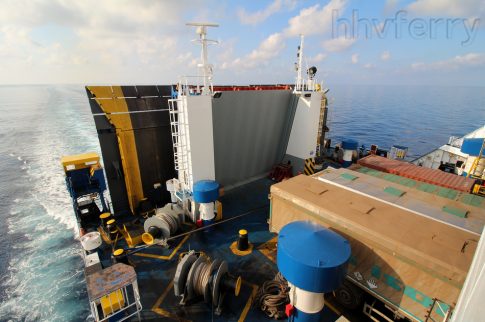




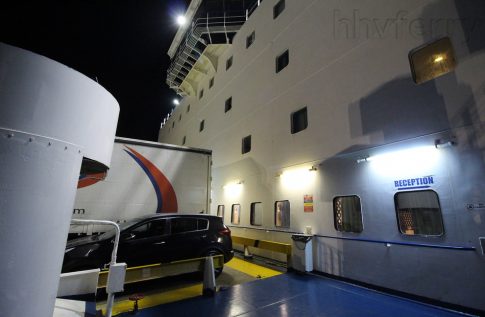
The Poseidon operation was taken over by Finnlines in 1997 but the Transeuropa remained registered in Germany and continued operating the Helsinki-L?beck service until the arrival of Finnlines? new ?Star? class from 2007 onwards. Thereafter the ship operated on other routes, such as the even longer L?beck- St Petersburg operation. The Italian Grimaldi Lines became the largest shareholder in Finnlines in 2007 and, six years later, the Transeuropa was moved to that company?s Italy to Greece operation from Brindisi to Igoumenitsa and Patras, subsequently in concert with the former Finnhansa. The two ships were renamed Euroferry Olympia and Euroferry Egnazia although the ?Olympia? subsequently saw some use in Italian domestic operation before the ?Egnazia? transferred to the Spanish Grimaldi-Trasmed services in 2021 where she remains, now named the Ciudad de Alcudia.
The other pair of ships, the Finnpartner and Finntrader, remain in Finnlines use, now operating for that company?s Nord?-Link subsidiary on the shorter route between Malm? and Travem?nde, for which they were quite substantially rebuilt and refurbished in 2007.


Grimaldi Lines
I have long been unimpressed with Grimaldi Lines, but this has primarily concerned their aggressive growth tactics, their standards of customer service and the quality, in terms of passenger comfort and fitout, of some of their ships. I was dismayed by their acquisitions of Finnlines, Minoan Lines and Trasmediterranea primarily because I worry about how they will compete in these markets and how they might diminish the service standards and reputations of these famous operators. Their reaction to this crisis did not therefore come as a great surprise.
Following an accusatory, and in parts incorrect, statement by the Greek Truck Drivers Union, Grimaldi released a perhaps ill-considered press release in which they defended the ship and specifically implied that the reason for the deaths was drivers being in their cabs:
?If any truck driver decides fraudulently to hide himself in his truck, this behaviour is a flagrant offense against International Regulations and Grimaldi rules which can put at risk his own and the ship?s safety.?
The reality is that the primary cause of the deaths, as far as is currently known, was that Grimaldi?s ship caught fire, not that the drivers remained with their vehicles. The drivers may have been in the wrong place, but there is currently no evidence that their presence caused the fire.
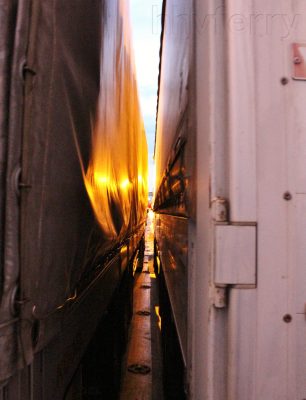
Adriatic Ferry safety

The most catastrophic car ferry fire in the Adriatic was that of Efthymiadis Lines? Heleanna, sailing from Patras to Ancona in August 1971, when a blaze beginning in the galley swept through the ship and ended in the deaths of 41 people. Fire protection, monitoring and response measures have improved vastly since the Heleanna but over the past 25 years there have been simply too many vehicle deck fires, many starting in refrigerated units or tractor units, for it any longer to be considered merely bad luck. And there have been too many ships with open vehicle decks where such fires burn uncontained for it to be merely coincidence. The loss of the Norman Atlantic was the most tragic in recent years but we can also look at the Lisco Gloria in 2010 and the Sorrento in 2015 ? in each case the fire broke out on an open or partially-open vehicle deck, in each the fire quickly overwhelmed the crew, in each the ship was a total loss.
Despite my doubts about Grimaldi Lines generally I have no reason to think that standards of safety on Grimaldi ships are any worse, or better, than those of other operators in the sectors in which they operate. Before the Norman Atlantic the most tragic vehicle deck fire incident in the Adriatic was the Superfast III in 1999 which led to the deaths of 14 Kurdish stowaways. This fire began in a reefer unit in the main deck and was extinguished by the ship?s drenching system and by crew firefighters after several hours. Other ferries in service to or in Greece to have endured vehicle deck fires include the Knossos Palace, Kriti II, El. Venizelos and Olympic Champion – but again, as with the Superfast III, in each of these cases the fires began on enclosed vehicle decks where there was less oxygen to feed the flames. And, although damage was in some cases extensive, the ships were not lost. It is perhaps significant that the driver rescued some time after the event on the Euroferry Olympia was reportedly on the lower, fully enclosed deck rather than the open upper ones.
The investigation report into the Kriti II fire noted that the trucks were parked too closely together to allow firefighting teams to get access, even if the theoretical loading plan provided for access routes around the vehicles. In theory the close parking which is a major feature of many Adriatic ships reduces the dangers of movement during heavy seas – but, in a fire situation, it can be a danger, limiting the ability of crew to get to the seat of a fire and most likely dooming any driver still in their cabs and unable to even open the doors to escape.

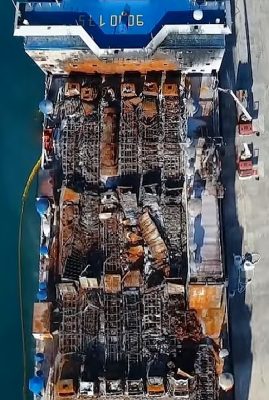
Drivers in cabins or cabs

One of the sad ironies of the Euroferry Olympia incident was that this was a ship which, as built, did everything right. Its standards of accommodation for truckers and tourists alike were exemplary ? large, modern cabins, with private facilities, comfortable saloons and high quality food. This quartet were exemplars of how to build modern ro-pax tonnage. When the ship was redeployed in Italian service it was given a rebuild with a new block of cabins added aft of the original superstructure. It is interesting to note that when the two sister ships which remained with Finnlines were rebuilt to a different design, with 160 extra cabins added on an intermediate Deck 3a in 2007, no fewer than 132 of them were single-berth rooms, specifically to give privacy to the truck drivers who would sail on the ships in their new roles. Passengers on the Euroferry Olympia were not so fortunate: the cabins added in 2013 were not as focussed on drivers as those given to the sister vessels, being predominantly four berth and equipped to Grimaldi?s familiar wipe-down, lino-floored, no-frills standard cabin design. The spacious original rooms were henceforth described as ?Superior cabins?.

Cabin accommodation is important to drivers, moreso since the start of the Covid pandemic when the demand for private rooms became even greater ? ships where drivers are placed in a small shared cabin with three strangers do not encourage them to stay there. Even before Covid, enlightened operators had slowly begun to deliver single berths rooms for drivers yet erroneous notes continue to be struck ? for example the decision of Brittany Ferries on their new E-flexers to provide small twin berth cabins without en-suite toilet and shower facilities is frankly unfathomable. The temptation remains, therefore, for some drivers to stay in their cabs, or more particularly the sleeping area adjacent, many of which are as comfortable as a ship?s cabin and which certainly have more privacy and, potentially, more home comforts. Finding a driver who has bedded down out of sight in their cab is almost impossible for crews ? and this is not an issue restricted to southern European ferries or to long haul routes.

What next
There are no easy answers to the ongoing series of ferry vehicle deck fires. Mitigation of the tragedies of lorry drivers dying in their cabs involves treating them at last like valued passengers with good, private accommodation. A careful look perhaps needs to be taken at the quality of the truck and trailer fleets being used on some routes where they are sometimes older, less well maintained and more prone to electrical issues. Yet this will not address the underlying problem of what happens when a fire does break out.
It is not clear what caused the fire on the Euroferry Olympia or even where it started ? but it appears that it was either on the partially-open Deck 3 or the fully open Deck 4. Whatever the cause however it?s clear the response cannot be to simply blame those who have died for being in the wrong place at the wrong time and move on.

Before the true flowering of the ro-pax ferry in the late 1980s, open freight decks on passenger ferries were relatively uncommon; perhaps an area would be made available for vehicles carrying dangerous goods outside the ship?s main, enclosed, fire-protected vehicle deck but little more. Since the delivery of ships like the Nils Dacke (1988) they have, almost without us noticing, become more and more common. Even without knowing the full details of the Euroferry Olympia incident, it’s fair to ask if this design is fundamentally unsound.
Given the number of ships with this format in service around the world such a serious and unsettling question will probably never be answered ?yes?. But can we really continue to see passenger ships burn and people die, to see crews so often totally overwhelmed by flames fed by the unlimited oxygen of the open vehicle deck? I doubt it will be palatable to seriously address this issue, but unless something is done, the repeated pattern of such ships burning out of control may be likely to continue.


